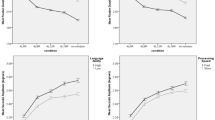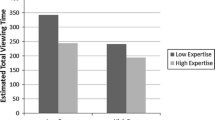Abstract
This study investigated whether readers are more likely to assign a male referent to man-suffix terms (e.g. chairman) than to gender-neutral alternatives (e.g., chairperson) during reading, and whether this bias differs as a function of age. Younger and older adults’ eye movements were monitored while reading passages containing phrases such as “The chairman/chairperson familiarized herself with…” On-line eye fixation data provided strong evidence that man-suffix words were more likely to evoke the expectation of a male referent in both age groups. Younger readers demonstrated inflated processing times when first encountering herself after chairman relative to chairperson, and they tended to make more regressive fixations to chairman. Older readers did not show the effect when initially encountering herself, but they spent disproportionately longer looking back to chairman and herself. The study provides empirical support for copy-editing policies that mandate the use of explicitly gender-neutral suffix terms in place of man-suffix terms.
Similar content being viewed by others
References
APA Publication Manual Task Force: (1977) Guidelines for nonsexist language in APA journals: Publication Manual change sheet 2. American Psychologist 3(2): 487–494
Baltes P. B. (1997) On the incomplete architecture of human ontogeny. American Psychologist 52: 366–380
Daneman M., Hannon B., Burton C. (2006) Are there age-related differences in shallow semantic processing of text? Evidence from eye movements. Discourse Processes 42: 177–203
Daneman M., Lennertz T., Hannon B. (2007) Shallow semantic processing of text: Evidence from eye movements. Language and Cognitive Processes 22: 83–105
Duffy S. A., Keir J. A. (2004) Violating stereotypes: Eye movements and comprehension processes when text conflicts with world knowledge. Memory & Cognition 32: 551–559
Duffy S. A., Rayner K. (1990) Eye movements and anaphor resolution: Effect of antecedent typicality and distance. Language & Speech 33: 1003–1019
Harper & Row Publishers Inc: (1976) Harper & Row guidelines on equal treatment of the sexes in textbooks. Harper & Row, New York
Holt, Rinehart & Winston (College Division): (1976) The treatment of sex roles and minorities. Holt, Rinehart & Winston, New York
Johnson R. E. (2003) Aging and the remembering of text. Developmental Review 23: 261–346
Kanfer S. (1972) Sispeak: A Ms-guided attempt to change herstory. Time 100(October 23): 79
Kennedy D. (1993) Nonsexist language: A progress report. Canadian Journal of Education 18: 223–238
Kreiner H., Sturt P., Garrod S. (2008) Processing definitional and stereotypical gender in reference resolution: Evidence from eye-movements. Journal of Memory and Language 58: 239–261
MacKay D. G. (1980) Psychology, prescriptive grammar, and the pronoun problem. American Psychologist 35: 444–449
Martyna W. (1980) Beyond the “he/man” approach: The case for nonsexist language. Signs 5: 482–493
McConnell A. R., Fazio R. H. (1996) Women as men and people: Effects of gender-marked language. Personality and Social Psychology Bulletin 22: 1004–1013
Merritt R. D., Kok C. J. (1995) Attribution of gender to a gender-unspecified individual: An evaluation of the people = male hypothesis. Sex Roles 33: 145–157
Moulton J., Robinson G. M., Elias C. (1978) Sex bias in language use: “Neutral” pronouns that aren’t. American Psychologist 33: 1032–1036
Murphy D., Daneman M., Schneider B. A. (2006) Why do older adults have difficulty following conversations?. Psychology and Aging 21: 49–61
Osterhout L., Bersick M., McLaughlin J. (1997) Brain potentials reflect violations of gender stereotypes. Memory & Cognition 25: 273–285
Prentice-Hall Inc: (1975) Prentice-Hall author’s guide (5th ed.). Prentice-Hall, Englewood Cliffs, NJ
Random House: (1975) Guidelines for multiethnic/nonsexist survey. Random House, New York
Raven J. C. (1965) The Mill Hill Vocabulary Scale. Lewis, London
Rayner K., Duffy S. A. (1986) Lexical complexity and fixation times in reading: Effects of word frequency, verb complexity, and lexical ambiguity. Memory & Cognition 14: 191–201
Rubin D. L., Greene K., Schneider J. W. (1994) Adopting gender-inclusive language reforms. Journal of Language and Social Psychology 13: 91–114
Schneider B. A., Daneman M., Murphy D. (2005) Speech comprehension difficulties in older adults: Cognitive slowing or age-related changes in hearing?. Psychology and Aging 20: 261–271
Schneider J. W., Hacker S. L. (1973) Sex role imagery and the use of generic “man” in introductory texts: A case in the sociology of sociology. American Sociologist 8: 12–18
Shen J., Reingold E. M., Pomplun M. (2003) Guidance of eye movements during conjunctive visual search: The distractor-ratio effect. Canadian Journal of Experimental Psychology 57: 76–96
Sturt P. (2003) The time-course of the application of binding constraints in reference resolution. Journal of Memory and Language 48: 542–562
Van Horne, H. (1976). Women’s movement foolishly assaults the English language. Rocky Mountain News (February 19), 51.
Author information
Authors and Affiliations
Corresponding author
Rights and permissions
About this article
Cite this article
Khan, M., Daneman, M. How Readers Spontaneously Interpret Man-Suffix Words: Evidence from Eye Movements. J Psycholinguist Res 40, 351 (2011). https://doi.org/10.1007/s10936-011-9173-3
Published:
DOI: https://doi.org/10.1007/s10936-011-9173-3




